Analyzing Google's Business Model Canvas and Success Factors
VerifiedAdded on 2023/06/14
|10
|2003
|319
Report
AI Summary
This report provides a detailed analysis of Google's business model, focusing on the nine building blocks of the business model canvas and their contribution to the company's success. It highlights Google's key partners, activities, resources, value propositions, customer relationships, channels, customer segments, cost structure, and revenue streams. The report identifies critical success factors such as Google's multi-sided platform business model, value proposition focused on targeted advertising and user-friendly platforms, strong revenue system, and high-quality human resources. By leveraging these factors, Google has achieved significant growth and maintained a competitive edge in the technology market. The report concludes that Google's well-defined business model and strategic focus on innovation and customer value are instrumental to its ongoing success.

Running Head: Business Report 1
Business Model Canvas
Business Model Canvas
Paraphrase This Document
Need a fresh take? Get an instant paraphrase of this document with our AI Paraphraser

Business Report 2
Contents
Introduction......................................................................................................................................3
Business model: Nine building blocks............................................................................................3
Critical success factors....................................................................................................................6
Conclusion.......................................................................................................................................7
Contents
Introduction......................................................................................................................................3
Business model: Nine building blocks............................................................................................3
Critical success factors....................................................................................................................6
Conclusion.......................................................................................................................................7
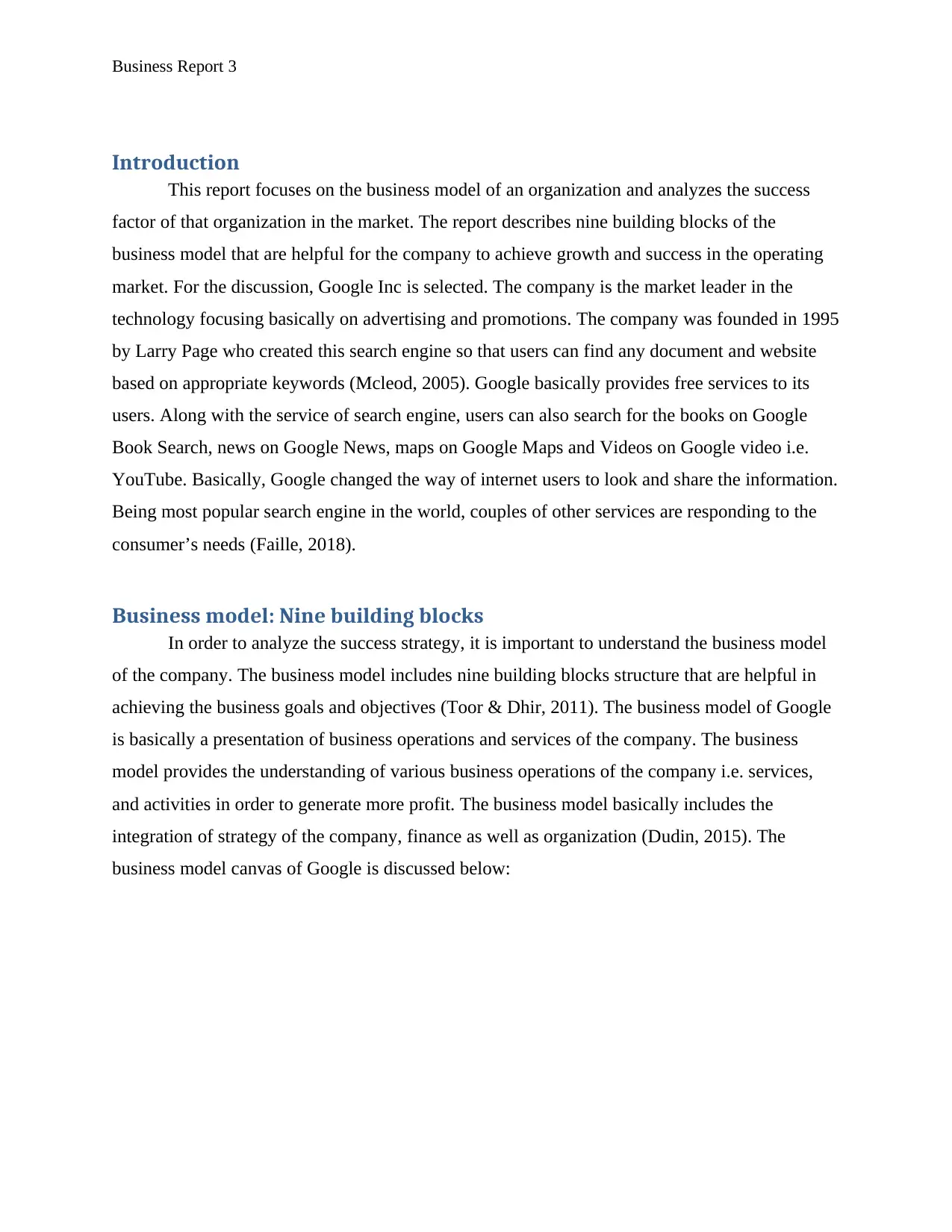
Business Report 3
Introduction
This report focuses on the business model of an organization and analyzes the success
factor of that organization in the market. The report describes nine building blocks of the
business model that are helpful for the company to achieve growth and success in the operating
market. For the discussion, Google Inc is selected. The company is the market leader in the
technology focusing basically on advertising and promotions. The company was founded in 1995
by Larry Page who created this search engine so that users can find any document and website
based on appropriate keywords (Mcleod, 2005). Google basically provides free services to its
users. Along with the service of search engine, users can also search for the books on Google
Book Search, news on Google News, maps on Google Maps and Videos on Google video i.e.
YouTube. Basically, Google changed the way of internet users to look and share the information.
Being most popular search engine in the world, couples of other services are responding to the
consumer’s needs (Faille, 2018).
Business model: Nine building blocks
In order to analyze the success strategy, it is important to understand the business model
of the company. The business model includes nine building blocks structure that are helpful in
achieving the business goals and objectives (Toor & Dhir, 2011). The business model of Google
is basically a presentation of business operations and services of the company. The business
model provides the understanding of various business operations of the company i.e. services,
and activities in order to generate more profit. The business model basically includes the
integration of strategy of the company, finance as well as organization (Dudin, 2015). The
business model canvas of Google is discussed below:
Introduction
This report focuses on the business model of an organization and analyzes the success
factor of that organization in the market. The report describes nine building blocks of the
business model that are helpful for the company to achieve growth and success in the operating
market. For the discussion, Google Inc is selected. The company is the market leader in the
technology focusing basically on advertising and promotions. The company was founded in 1995
by Larry Page who created this search engine so that users can find any document and website
based on appropriate keywords (Mcleod, 2005). Google basically provides free services to its
users. Along with the service of search engine, users can also search for the books on Google
Book Search, news on Google News, maps on Google Maps and Videos on Google video i.e.
YouTube. Basically, Google changed the way of internet users to look and share the information.
Being most popular search engine in the world, couples of other services are responding to the
consumer’s needs (Faille, 2018).
Business model: Nine building blocks
In order to analyze the success strategy, it is important to understand the business model
of the company. The business model includes nine building blocks structure that are helpful in
achieving the business goals and objectives (Toor & Dhir, 2011). The business model of Google
is basically a presentation of business operations and services of the company. The business
model provides the understanding of various business operations of the company i.e. services,
and activities in order to generate more profit. The business model basically includes the
integration of strategy of the company, finance as well as organization (Dudin, 2015). The
business model canvas of Google is discussed below:
⊘ This is a preview!⊘
Do you want full access?
Subscribe today to unlock all pages.

Trusted by 1+ million students worldwide
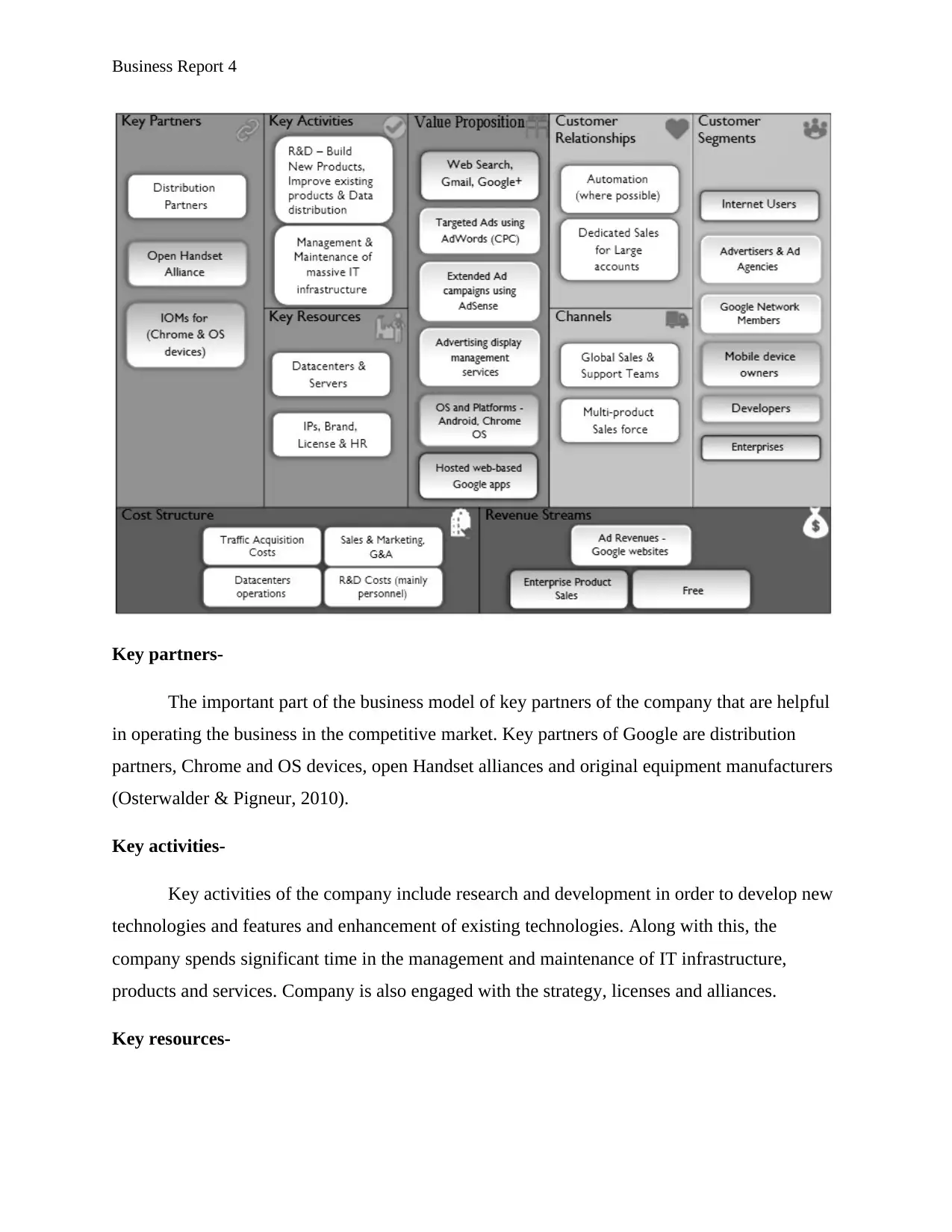
Business Report 4
Key partners-
The important part of the business model of key partners of the company that are helpful
in operating the business in the competitive market. Key partners of Google are distribution
partners, Chrome and OS devices, open Handset alliances and original equipment manufacturers
(Osterwalder & Pigneur, 2010).
Key activities-
Key activities of the company include research and development in order to develop new
technologies and features and enhancement of existing technologies. Along with this, the
company spends significant time in the management and maintenance of IT infrastructure,
products and services. Company is also engaged with the strategy, licenses and alliances.
Key resources-
Key partners-
The important part of the business model of key partners of the company that are helpful
in operating the business in the competitive market. Key partners of Google are distribution
partners, Chrome and OS devices, open Handset alliances and original equipment manufacturers
(Osterwalder & Pigneur, 2010).
Key activities-
Key activities of the company include research and development in order to develop new
technologies and features and enhancement of existing technologies. Along with this, the
company spends significant time in the management and maintenance of IT infrastructure,
products and services. Company is also engaged with the strategy, licenses and alliances.
Key resources-
Paraphrase This Document
Need a fresh take? Get an instant paraphrase of this document with our AI Paraphraser
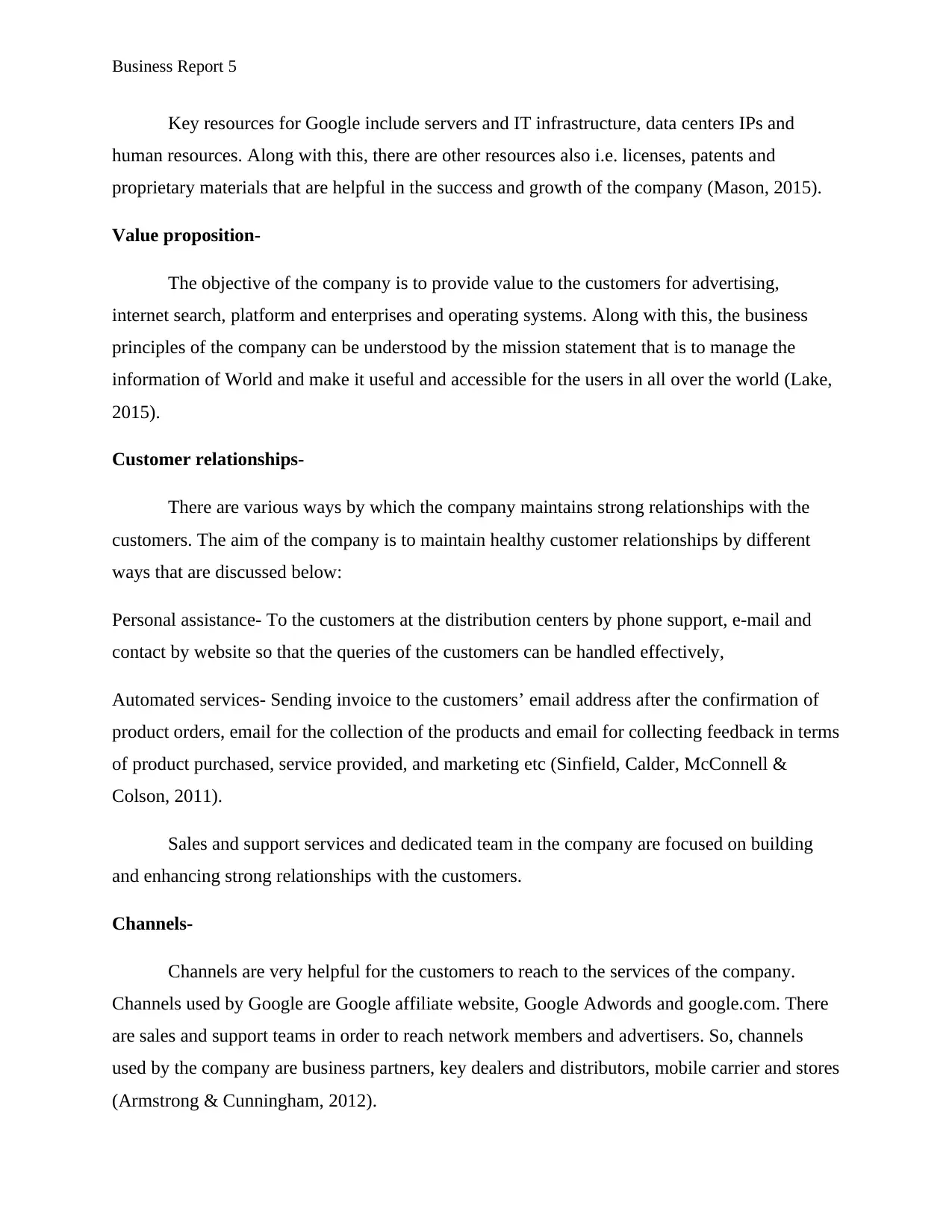
Business Report 5
Key resources for Google include servers and IT infrastructure, data centers IPs and
human resources. Along with this, there are other resources also i.e. licenses, patents and
proprietary materials that are helpful in the success and growth of the company (Mason, 2015).
Value proposition-
The objective of the company is to provide value to the customers for advertising,
internet search, platform and enterprises and operating systems. Along with this, the business
principles of the company can be understood by the mission statement that is to manage the
information of World and make it useful and accessible for the users in all over the world (Lake,
2015).
Customer relationships-
There are various ways by which the company maintains strong relationships with the
customers. The aim of the company is to maintain healthy customer relationships by different
ways that are discussed below:
Personal assistance- To the customers at the distribution centers by phone support, e-mail and
contact by website so that the queries of the customers can be handled effectively,
Automated services- Sending invoice to the customers’ email address after the confirmation of
product orders, email for the collection of the products and email for collecting feedback in terms
of product purchased, service provided, and marketing etc (Sinfield, Calder, McConnell &
Colson, 2011).
Sales and support services and dedicated team in the company are focused on building
and enhancing strong relationships with the customers.
Channels-
Channels are very helpful for the customers to reach to the services of the company.
Channels used by Google are Google affiliate website, Google Adwords and google.com. There
are sales and support teams in order to reach network members and advertisers. So, channels
used by the company are business partners, key dealers and distributors, mobile carrier and stores
(Armstrong & Cunningham, 2012).
Key resources for Google include servers and IT infrastructure, data centers IPs and
human resources. Along with this, there are other resources also i.e. licenses, patents and
proprietary materials that are helpful in the success and growth of the company (Mason, 2015).
Value proposition-
The objective of the company is to provide value to the customers for advertising,
internet search, platform and enterprises and operating systems. Along with this, the business
principles of the company can be understood by the mission statement that is to manage the
information of World and make it useful and accessible for the users in all over the world (Lake,
2015).
Customer relationships-
There are various ways by which the company maintains strong relationships with the
customers. The aim of the company is to maintain healthy customer relationships by different
ways that are discussed below:
Personal assistance- To the customers at the distribution centers by phone support, e-mail and
contact by website so that the queries of the customers can be handled effectively,
Automated services- Sending invoice to the customers’ email address after the confirmation of
product orders, email for the collection of the products and email for collecting feedback in terms
of product purchased, service provided, and marketing etc (Sinfield, Calder, McConnell &
Colson, 2011).
Sales and support services and dedicated team in the company are focused on building
and enhancing strong relationships with the customers.
Channels-
Channels are very helpful for the customers to reach to the services of the company.
Channels used by Google are Google affiliate website, Google Adwords and google.com. There
are sales and support teams in order to reach network members and advertisers. So, channels
used by the company are business partners, key dealers and distributors, mobile carrier and stores
(Armstrong & Cunningham, 2012).
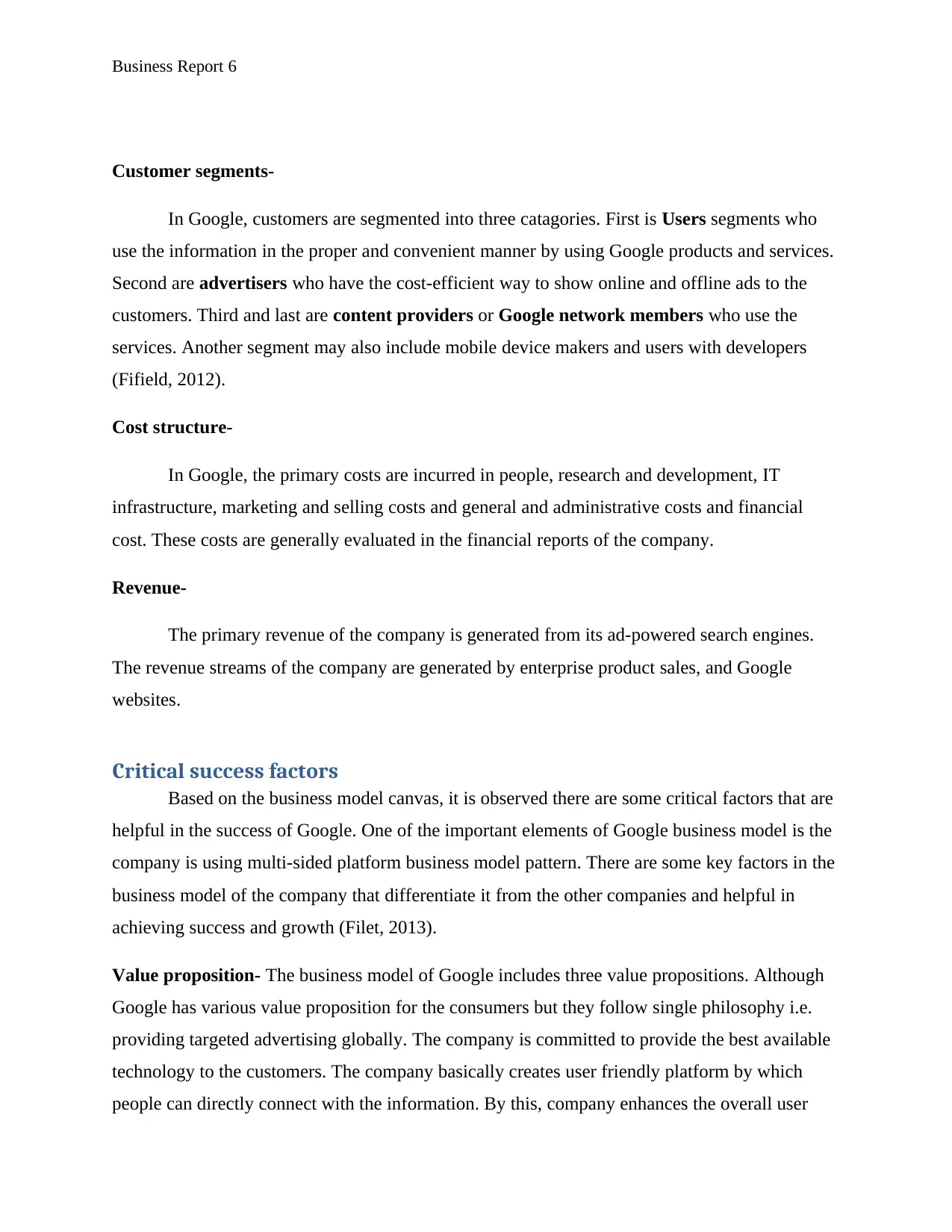
Business Report 6
Customer segments-
In Google, customers are segmented into three catagories. First is Users segments who
use the information in the proper and convenient manner by using Google products and services.
Second are advertisers who have the cost-efficient way to show online and offline ads to the
customers. Third and last are content providers or Google network members who use the
services. Another segment may also include mobile device makers and users with developers
(Fifield, 2012).
Cost structure-
In Google, the primary costs are incurred in people, research and development, IT
infrastructure, marketing and selling costs and general and administrative costs and financial
cost. These costs are generally evaluated in the financial reports of the company.
Revenue-
The primary revenue of the company is generated from its ad-powered search engines.
The revenue streams of the company are generated by enterprise product sales, and Google
websites.
Critical success factors
Based on the business model canvas, it is observed there are some critical factors that are
helpful in the success of Google. One of the important elements of Google business model is the
company is using multi-sided platform business model pattern. There are some key factors in the
business model of the company that differentiate it from the other companies and helpful in
achieving success and growth (Filet, 2013).
Value proposition- The business model of Google includes three value propositions. Although
Google has various value proposition for the consumers but they follow single philosophy i.e.
providing targeted advertising globally. The company is committed to provide the best available
technology to the customers. The company basically creates user friendly platform by which
people can directly connect with the information. By this, company enhances the overall user
Customer segments-
In Google, customers are segmented into three catagories. First is Users segments who
use the information in the proper and convenient manner by using Google products and services.
Second are advertisers who have the cost-efficient way to show online and offline ads to the
customers. Third and last are content providers or Google network members who use the
services. Another segment may also include mobile device makers and users with developers
(Fifield, 2012).
Cost structure-
In Google, the primary costs are incurred in people, research and development, IT
infrastructure, marketing and selling costs and general and administrative costs and financial
cost. These costs are generally evaluated in the financial reports of the company.
Revenue-
The primary revenue of the company is generated from its ad-powered search engines.
The revenue streams of the company are generated by enterprise product sales, and Google
websites.
Critical success factors
Based on the business model canvas, it is observed there are some critical factors that are
helpful in the success of Google. One of the important elements of Google business model is the
company is using multi-sided platform business model pattern. There are some key factors in the
business model of the company that differentiate it from the other companies and helpful in
achieving success and growth (Filet, 2013).
Value proposition- The business model of Google includes three value propositions. Although
Google has various value proposition for the consumers but they follow single philosophy i.e.
providing targeted advertising globally. The company is committed to provide the best available
technology to the customers. The company basically creates user friendly platform by which
people can directly connect with the information. By this, company enhances the overall user
⊘ This is a preview!⊘
Do you want full access?
Subscribe today to unlock all pages.

Trusted by 1+ million students worldwide
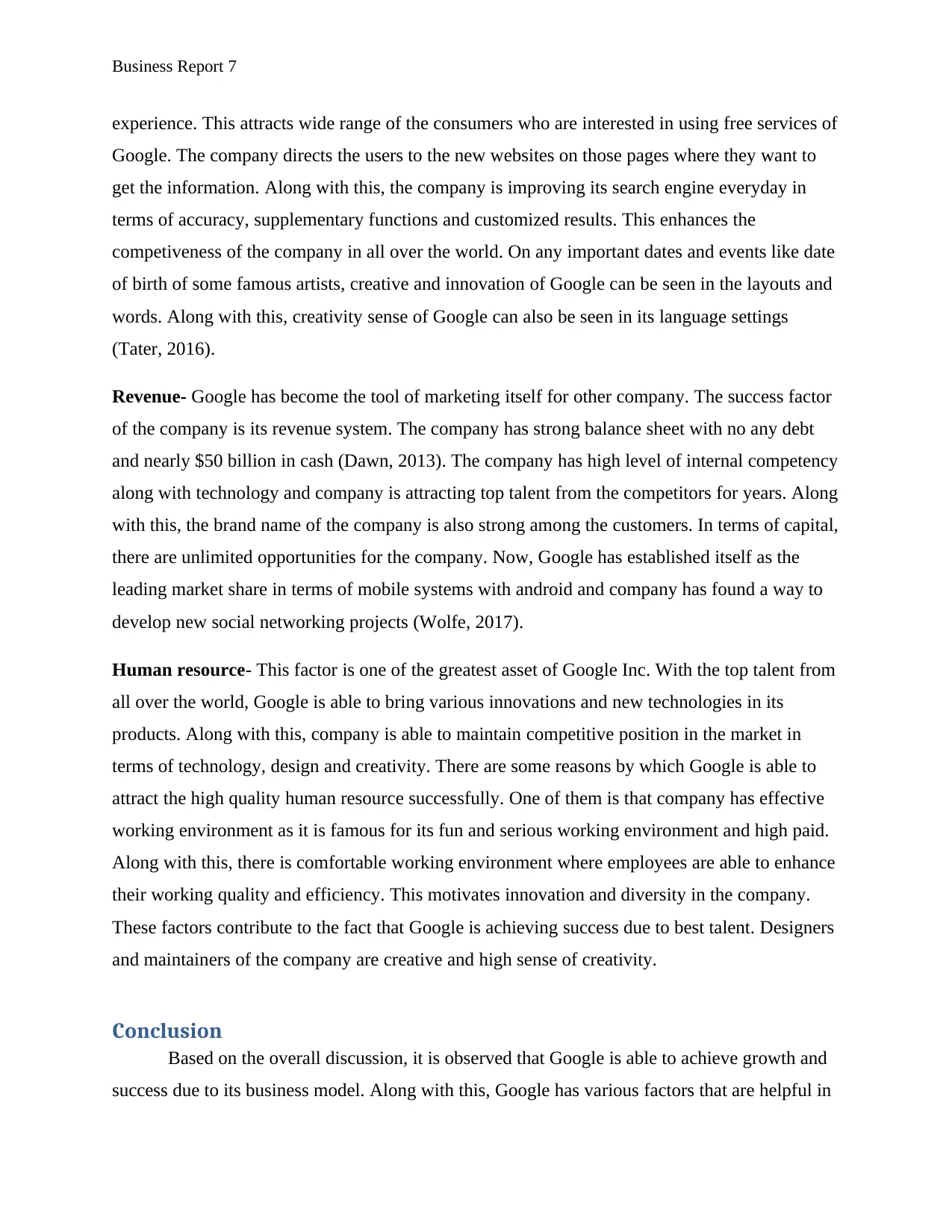
Business Report 7
experience. This attracts wide range of the consumers who are interested in using free services of
Google. The company directs the users to the new websites on those pages where they want to
get the information. Along with this, the company is improving its search engine everyday in
terms of accuracy, supplementary functions and customized results. This enhances the
competiveness of the company in all over the world. On any important dates and events like date
of birth of some famous artists, creative and innovation of Google can be seen in the layouts and
words. Along with this, creativity sense of Google can also be seen in its language settings
(Tater, 2016).
Revenue- Google has become the tool of marketing itself for other company. The success factor
of the company is its revenue system. The company has strong balance sheet with no any debt
and nearly $50 billion in cash (Dawn, 2013). The company has high level of internal competency
along with technology and company is attracting top talent from the competitors for years. Along
with this, the brand name of the company is also strong among the customers. In terms of capital,
there are unlimited opportunities for the company. Now, Google has established itself as the
leading market share in terms of mobile systems with android and company has found a way to
develop new social networking projects (Wolfe, 2017).
Human resource- This factor is one of the greatest asset of Google Inc. With the top talent from
all over the world, Google is able to bring various innovations and new technologies in its
products. Along with this, company is able to maintain competitive position in the market in
terms of technology, design and creativity. There are some reasons by which Google is able to
attract the high quality human resource successfully. One of them is that company has effective
working environment as it is famous for its fun and serious working environment and high paid.
Along with this, there is comfortable working environment where employees are able to enhance
their working quality and efficiency. This motivates innovation and diversity in the company.
These factors contribute to the fact that Google is achieving success due to best talent. Designers
and maintainers of the company are creative and high sense of creativity.
Conclusion
Based on the overall discussion, it is observed that Google is able to achieve growth and
success due to its business model. Along with this, Google has various factors that are helpful in
experience. This attracts wide range of the consumers who are interested in using free services of
Google. The company directs the users to the new websites on those pages where they want to
get the information. Along with this, the company is improving its search engine everyday in
terms of accuracy, supplementary functions and customized results. This enhances the
competiveness of the company in all over the world. On any important dates and events like date
of birth of some famous artists, creative and innovation of Google can be seen in the layouts and
words. Along with this, creativity sense of Google can also be seen in its language settings
(Tater, 2016).
Revenue- Google has become the tool of marketing itself for other company. The success factor
of the company is its revenue system. The company has strong balance sheet with no any debt
and nearly $50 billion in cash (Dawn, 2013). The company has high level of internal competency
along with technology and company is attracting top talent from the competitors for years. Along
with this, the brand name of the company is also strong among the customers. In terms of capital,
there are unlimited opportunities for the company. Now, Google has established itself as the
leading market share in terms of mobile systems with android and company has found a way to
develop new social networking projects (Wolfe, 2017).
Human resource- This factor is one of the greatest asset of Google Inc. With the top talent from
all over the world, Google is able to bring various innovations and new technologies in its
products. Along with this, company is able to maintain competitive position in the market in
terms of technology, design and creativity. There are some reasons by which Google is able to
attract the high quality human resource successfully. One of them is that company has effective
working environment as it is famous for its fun and serious working environment and high paid.
Along with this, there is comfortable working environment where employees are able to enhance
their working quality and efficiency. This motivates innovation and diversity in the company.
These factors contribute to the fact that Google is achieving success due to best talent. Designers
and maintainers of the company are creative and high sense of creativity.
Conclusion
Based on the overall discussion, it is observed that Google is able to achieve growth and
success due to its business model. Along with this, Google has various factors that are helpful in
Paraphrase This Document
Need a fresh take? Get an instant paraphrase of this document with our AI Paraphraser

Business Report 8
achieving success in the market. In the business model, there are nine building blocks that
represent the services of the company provided to the student. Company provides value
propositions to the customers. This attracts wide range of the consumers who are interested in
using free services of Google.
achieving success in the market. In the business model, there are nine building blocks that
represent the services of the company provided to the student. Company provides value
propositions to the customers. This attracts wide range of the consumers who are interested in
using free services of Google.
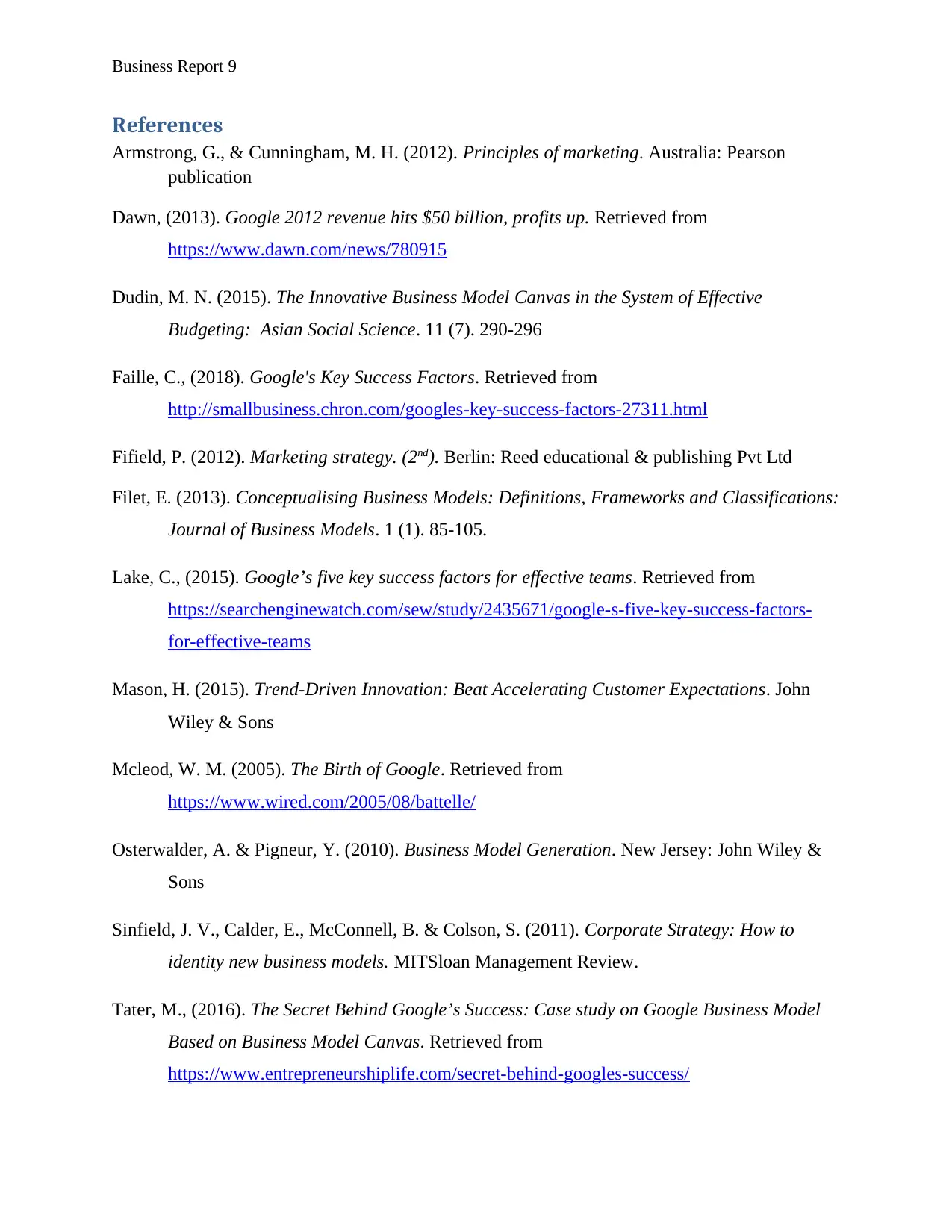
Business Report 9
References
Armstrong, G., & Cunningham, M. H. (2012). Principles of marketing. Australia: Pearson
publication
Dawn, (2013). Google 2012 revenue hits $50 billion, profits up. Retrieved from
https://www.dawn.com/news/780915
Dudin, M. N. (2015). The Innovative Business Model Canvas in the System of Effective
Budgeting: Asian Social Science. 11 (7). 290-296
Faille, C., (2018). Google's Key Success Factors. Retrieved from
http://smallbusiness.chron.com/googles-key-success-factors-27311.html
Fifield, P. (2012). Marketing strategy. (2nd). Berlin: Reed educational & publishing Pvt Ltd
Filet, E. (2013). Conceptualising Business Models: Definitions, Frameworks and Classifications:
Journal of Business Models. 1 (1). 85-105.
Lake, C., (2015). Google’s five key success factors for effective teams. Retrieved from
https://searchenginewatch.com/sew/study/2435671/google-s-five-key-success-factors-
for-effective-teams
Mason, H. (2015). Trend-Driven Innovation: Beat Accelerating Customer Expectations. John
Wiley & Sons
Mcleod, W. M. (2005). The Birth of Google. Retrieved from
https://www.wired.com/2005/08/battelle/
Osterwalder, A. & Pigneur, Y. (2010). Business Model Generation. New Jersey: John Wiley &
Sons
Sinfield, J. V., Calder, E., McConnell, B. & Colson, S. (2011). Corporate Strategy: How to
identity new business models. MITSloan Management Review.
Tater, M., (2016). The Secret Behind Google’s Success: Case study on Google Business Model
Based on Business Model Canvas. Retrieved from
https://www.entrepreneurshiplife.com/secret-behind-googles-success/
References
Armstrong, G., & Cunningham, M. H. (2012). Principles of marketing. Australia: Pearson
publication
Dawn, (2013). Google 2012 revenue hits $50 billion, profits up. Retrieved from
https://www.dawn.com/news/780915
Dudin, M. N. (2015). The Innovative Business Model Canvas in the System of Effective
Budgeting: Asian Social Science. 11 (7). 290-296
Faille, C., (2018). Google's Key Success Factors. Retrieved from
http://smallbusiness.chron.com/googles-key-success-factors-27311.html
Fifield, P. (2012). Marketing strategy. (2nd). Berlin: Reed educational & publishing Pvt Ltd
Filet, E. (2013). Conceptualising Business Models: Definitions, Frameworks and Classifications:
Journal of Business Models. 1 (1). 85-105.
Lake, C., (2015). Google’s five key success factors for effective teams. Retrieved from
https://searchenginewatch.com/sew/study/2435671/google-s-five-key-success-factors-
for-effective-teams
Mason, H. (2015). Trend-Driven Innovation: Beat Accelerating Customer Expectations. John
Wiley & Sons
Mcleod, W. M. (2005). The Birth of Google. Retrieved from
https://www.wired.com/2005/08/battelle/
Osterwalder, A. & Pigneur, Y. (2010). Business Model Generation. New Jersey: John Wiley &
Sons
Sinfield, J. V., Calder, E., McConnell, B. & Colson, S. (2011). Corporate Strategy: How to
identity new business models. MITSloan Management Review.
Tater, M., (2016). The Secret Behind Google’s Success: Case study on Google Business Model
Based on Business Model Canvas. Retrieved from
https://www.entrepreneurshiplife.com/secret-behind-googles-success/
⊘ This is a preview!⊘
Do you want full access?
Subscribe today to unlock all pages.

Trusted by 1+ million students worldwide

Business Report 10
Toor, T. P. & Dhir, T. (2011). Benefits of integrated business planning, forecasting, and process
management: Business Strategy Series. 275-288
Wolfe, L., (2017). How Google's Business Model Works. Retrieved from
https://www.thebalance.com/how-google-s-business-model-works-3515189
Toor, T. P. & Dhir, T. (2011). Benefits of integrated business planning, forecasting, and process
management: Business Strategy Series. 275-288
Wolfe, L., (2017). How Google's Business Model Works. Retrieved from
https://www.thebalance.com/how-google-s-business-model-works-3515189
1 out of 10
Related Documents
Your All-in-One AI-Powered Toolkit for Academic Success.
+13062052269
info@desklib.com
Available 24*7 on WhatsApp / Email
![[object Object]](/_next/static/media/star-bottom.7253800d.svg)
Unlock your academic potential
Copyright © 2020–2025 A2Z Services. All Rights Reserved. Developed and managed by ZUCOL.





